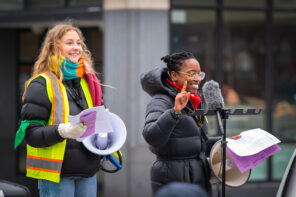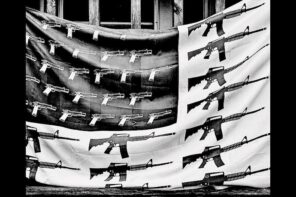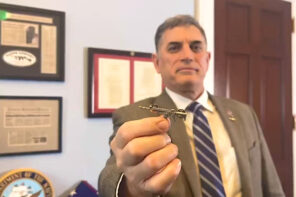It should come as no surprise that the Supreme Court once again ruled in favor of the religious culture of the gun, finding as it did on Monday that Chicago’s strict handgun prohibition was unconstitutional. To help understand why gun rights continue to exert such a pull on the American imagination we resurrect the following, written by RD’s Director Gary Laderman. — ed.
The sacred status of the gun is reaffirmed in this ruling unconstitutional rights and ensures its religious security in the hearts and homes of Americans across the land. In the words of LaPierre,“I consider this the opening salvo in a step-by-step process of providing relief for law-abiding Americans everywhere that have been deprived of this freedom.” The sacred formula: “guns=security=freedom” continues to be one of the primary moral codes of our nation, and violence and the threat of violence will remain a righteous tradition for future generations.
Arguments about social policy and Constitutional rights, however, miss an essential point about the religious stakes in the decision: guns are sacred to many Americans, and like other powerful religious objects they can either be a supreme source of comfort or they can lead, just as often, to dangerous behavior.
In American culture, the gun is the religious object par excellence—as American as baseball and apple pie, but cherished in ways that signal the deepest religious commitments and attachments. This sacrality is not due to any association with a divinity or Holy Scripture, but to a different set of reasons tied to our imagined past, national identity, and, perhaps most poignantly, the right to be violent.
More than anything else, a gun is a source of power (ultimate power, given that it can end a life with minimal effort) that many Americans will never surrender under any circumstances. Like the Bible or the cross, or a holy relic or sacred temple, guns inspire the most fervent investments from individuals who will fight off any perceived threat from outsiders with designs on controlling and regulating these weapons; whether they’re representatives of the government, the church, or the police.
Guns are ubiquitous across the American cultural landscape—a crucial element in historical memory about the past, across myriad forms of popular entertainment from Hollywood films to rap music, throughout political and civic discussions about crime and crime prevention, and safely (or not too safely) stored in homes and businesses in every corner of the nation.
With the emergence of the “cult of the colt” after Samuel Colt’s innovative design for a repeating revolver in 1836, on through the post-Civil War industrialization that led to intensified production and technological innovation in gun manufacturing to accommodate the expanding market, all the way up to the present, when AK-47s, sniper rifles, and a variety of other deadly and glamorous weapons are readily available for a violence-loving public, Americans have been fixated on the alluring power of guns.
While guns and God often go hand in hand for Americans who proclaim their constitutional right to bear arms, authority from a book is not essential to the religious rhetoric of those who presume that violence is an inevitable fact of life. Armed with this primal vision of human nature, and the concomitant moral understanding of both the role of government and the rights of individuals, these advocates for the gun see it not simply as a profane tool for protection and survival, but as a cosmic means of purification in the never-ending battle against the forces of evil lurking throughout good society.
The potential for transcendent righteous violence contained in the all-too-material plastic and steel, ammo and casings, offers sacred security as a bulwark against these ever-present social dangers—even when folks who own guns also use them for the sheer pleasures of visiting the local firing range or tracking and killing wild, defenseless animals. It is a distinctive source of treasured cultural activities, from hunting to collecting, blended with consecrated social values, like protecting the family and preserving individual freedoms.
Americans worship their guns, though no church is necessary to unify the community of believers connected by shared moral visions, ultimate values, and rejuvenating rituals. From Davy Crockett’s exploits on the frontier to Neo’s superhuman heroics in The Matrix; from Halo’s supernatural pull in the gaming world to John Wayne’s swagger as the cinematic embodiment of a cowboy with “true grit”, pulling the trigger or watching others pull the trigger has tremendous symbolic, and real-world, resonances. Especially in a country continually gripped by persistent fear of others: savage Indians, way back when, uncivilized blacks in the not too distant past, power-hungry government officials yesterday and today, and of course the ubiquitous threats from criminal elements in society.
The sacred aura surrounding guns is not just tied to material power or symbolic resonances; it is also spiritually infused by a peculiarly American religious text, a venerated, inviolable document at the core of national identity: the United States Constitution.
For gun lovers, the seventeen words in the Second Amendment to the Constitution is the sacred source with the authority to transform mere matter into something holy: “A well-regulated militia being necessary to the security of a free state, the right of the people to keep and bear arms shall not be infringed.”
But make no mistake about it; guns are lifted to the level of sacred when they are intimately linked with the promise of redemptive violence. Perhaps no other American institution embodies and articulates these sacred principles about gun ownership and the sacrality of the Second Amendment better, and more powerfully, than the revered and feared National Rifle Association, or NRA.
This culture reveres the gun as totem that ritually and mythically unites living Americans with dead Founding Fathers, past generations with future generations, and individual families with a national family; all of whom are mystically wound around the Godless-yet-sacred Second Amendment. The persistent fear that this amendment is under siege and must be defended motivates and animates the social energies (tied to more secular activities like lobbying and fundraising, but also bound up in gun worship) that drive the NRA and ensure its continued existence.
While God may or may not be invoked by NRA members and leaders, the religious messages about freedom and patriotism are easily established without recourse to elaborated and detailed theological rhetoric; like any good religious commitment, truth is self-evident, available for all to see.
Listen to the words of former NRA president Wayne LaPierre, who asserted in a recent speech that after many setbacks in the 1970s and 1980s, members of the NRA can be proud of all the accomplishments and victories the organization has seen recently in restoring the threatened integrity of the Second Amendment (including ensuring that John Kerry is not president and that Hilary Clinton will never be president).
He sermonizes: “Because you restored the Second Amendment, this freedom can be passed on to your children, and to their children and to their children’s children. The most precious of birthrights can be conferred upon every infant whose first breath is drawn beneath our American skies.” The most precious of birthrights, in this mythology, is not the right to religious freedom or equality under the law, or even to have shelter and clothing, but instead to own and shoot guns.
In a culture that has witnessed the horrors of Columbine and the senselessness of Virginia Tech, guns have the power to produce wrenching secular carnage for families and friends of the victims as well as compelling glorified martyrs for the thriving subculture that venerates the perpetrators. Guns don’t kill people, opponents of gun control assert, people kill people.
Or, to put it more biblically: Hate the sinner, love the gun.
[Scholar Lou Ruprecht’s response to the below column can be found here —ed.]



